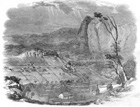Part 2 The Avon Valley
In the first part of this presentation we looked at how early colonists to the Upper Swan responded to the landscape and the extent to which they called Western Australia 'home'.
In Part 2 we move east to the Avon Valley and also forward in time to take a brief look at how Eliza and Thomas Brown, Henry Maxwell Lefroy and Edmund Ashworth settled into place in the new Colony.
In July 1830 a group led by Ensign Dale explored the Avon Valley and found it suitable for farming. In his journal from an expedition in 1832 he observed that:
...the soil is a rich dark loam, in many places red loam, & a good deal of gravel - the soil improved as we approached the river, & we passed through a very beautiful country. [1]

Six months later the region had been surveyed and land grants issued, but due to the distance from the Swan River, settlement was relatively slow and much of the land was taken up by absent landlords who never intended to live there.[2]
By the 1840s though, this land with river flats and red and brown soils had attracted a number of European settlers; perhaps encouraged by accounts such as J.W.F Blundell's romantic description of the area:
This fertilising river, which is, in fact, the main tributary of the Swan, was meandering gently between rich flats of alluvial soil; and herds of fat cattle were quietly browsing upon its pastures, or standing in pleasing groups upon the shady sides of the surrounding hills. At length, on the opposite bank, relieving the eye of the monotonous forest-clad hills around, rose substantial farm buildings, and next fields of waving corn burst in all their verdant freshness upon the sight.[3]
The Lefroy name is familiar to many West Australians as three family members, Henry Maxwell, Anthony O'Grady and Gerald de Courcy, came here from England and Ireland during the 1840s. Henry Maxwell Lefroy, who first arrived at the Swan River in January 1841, is best known as the Superintendent of Fremantle Prison from 1859-75, but less is known about how he settled into the Colony. Eliza Brown and her husband Thomas also came to Western Australia in 1841 and their story attracted attention in 1977 when Peter Cowan published some of their letters.[4]
The existing records of Edmund Ashworth, who is the only working class colonists included in this presentation, do not include numerous letters or a detailed journal, but it is interesting to see what can be gleaned about his relationship to place from his brief diary and one surviving letter.
Page last updated: Thursday 22 September 2011 by Illona Tobin Asset ID 41491
Editors for this page nick 2nd account
login




